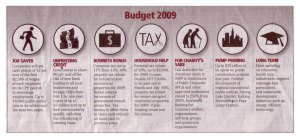Lots of of numbers and something for everyone, the Budget 2009 announcement yesterday was a great opportunity for the use of information graphics — so which local English paper did it best?
Most engaging concept: The New Paper
You have to give it to the tabloid paper for always trying to make the news accessible and interesting for its readers. Conceptually, the umbrella, an everyday object, to protect you from bad weather is a great analogy of the Budget announcement and something anyone can relate to. And instead of going for the big numbers, it divides the details into neat packages depending on who you are, a businessman, a tax-payer, an adult Singaporean…
This paper covered all the necessary details in a quarter of a page and with an interesting concept to boot! It clearly knows who its readers are as it divides the budget coverage into clear sections that are represented as “pills”. Not only are you able to get the information in a glance, the graphic also points you to the pages if you plan to read more on the given section.
Most grand concept: The Straits Times (ST)
A full cover and big numbers — when the Budget is discussed in terms of billions, it is hard to relate to it as a person on the street. The paper decided to go for the helicopter-view of things and emphasise on the massive figures as the news point. Unlike TODAY, the infographic does not serve to lead on to the other sections but in its special Budget section, it does divide it to relevant parts for different readers. The paper is definitely aiming to provide depth with an individual section just for the Budget and it clearly expects its readers to read everything on it. Whether this actually pans out in reality, I remain sceptical.
Most no-frills concept: Business Times (BT) & My Paper
Both papers chose to keep things simple, limiting any graphic to just a box and relevant sections. My Paper (right) is clearly more people-oriented while BT’s (left) angle was more for the businessmen.
How do other newspapers cover the Budget? Here is the Spanish 2008 Budget as covered by a Spanish newspaper, Público
This is definitely not something that would work for a TNP reader, but I would hope to see out of ST, BT or TODAY. It is a sophisicated infographic that shows the complexity and massive figures of the budget instead of telling it by using different colours and sizes for its “pipes”.
Since ST went for the helicopter-view of things, such a graphic would have been a great companion to its pages and pages of text. In fact, it would be something I want to pull out and keep just so I know the Budget 2009 inside out!





